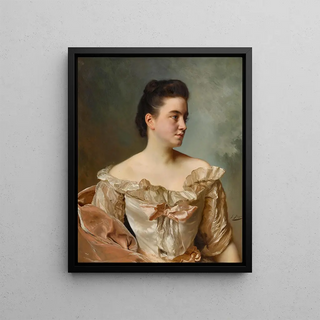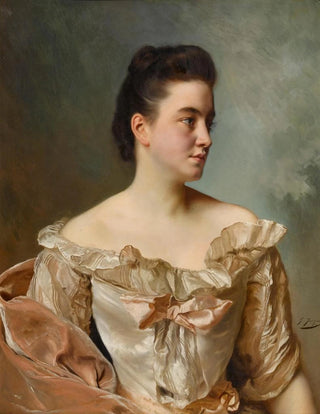Art print | A portrait of a lady in pink - Gustave Jean Jacquet


View from behind

Frame (optional)
At the heart of 19th-century Parisian salons, a work stands out for its elegance and delicacy. "A portrait of a lady in pink" by Gustave Jean Jacquet is a piece that invites contemplation, revealing the subtleties of the human soul through the lens of clothing and posture. This artwork, imbued with a romantic atmosphere, transports us to a world where beauty and refinement are omnipresent. The lady, dressed in a delicate pink dress, appears both mysterious and approachable, capturing the attention of anyone who meets her gaze. The soft light surrounding her accentuates her aura, making this art print not only a representation but a true window into a bygone era.
Style and uniqueness of the work
Jacquet's style is characterized by an exceptional mastery of color and light, elements that harmoniously combine to bring his subjects to life. In "A portrait of a lady in pink," the color palette is subtly chosen, oscillating between pastel shades and deeper nuances that create a striking contrast. The texture of the dress, rendered with remarkable precision, seems almost tangible, while the lady's face, of infinite softness, expresses an emotional depth that touches the viewer. The artist skillfully plays with shadows and highlights to sculpt the face and hands, giving his subject an almost lifelike presence. This art print, far from being a simple static image, becomes an invitation to explore the emotions and thoughts of the beautiful lady.
The artist and his influence
Gustave Jean Jacquet, an emblematic figure of French academic painting, distinguished himself with his unique approach to portraiture. Influenced by the great masters of the past, he reinterpreted the codes of classical painting while infusing his own sensitivity. His work is marked by a particular attention to detail and a capacity to capture the essence of his models. Jacquet also contributed to the evolution of the art print by incorporating elements of daily life, making his works more accessible and closer to the viewer. His influence endures, inspiring many contemporary artists who

Matte finish

View from behind

Frame (optional)
At the heart of 19th-century Parisian salons, a work stands out for its elegance and delicacy. "A portrait of a lady in pink" by Gustave Jean Jacquet is a piece that invites contemplation, revealing the subtleties of the human soul through the lens of clothing and posture. This artwork, imbued with a romantic atmosphere, transports us to a world where beauty and refinement are omnipresent. The lady, dressed in a delicate pink dress, appears both mysterious and approachable, capturing the attention of anyone who meets her gaze. The soft light surrounding her accentuates her aura, making this art print not only a representation but a true window into a bygone era.
Style and uniqueness of the work
Jacquet's style is characterized by an exceptional mastery of color and light, elements that harmoniously combine to bring his subjects to life. In "A portrait of a lady in pink," the color palette is subtly chosen, oscillating between pastel shades and deeper nuances that create a striking contrast. The texture of the dress, rendered with remarkable precision, seems almost tangible, while the lady's face, of infinite softness, expresses an emotional depth that touches the viewer. The artist skillfully plays with shadows and highlights to sculpt the face and hands, giving his subject an almost lifelike presence. This art print, far from being a simple static image, becomes an invitation to explore the emotions and thoughts of the beautiful lady.
The artist and his influence
Gustave Jean Jacquet, an emblematic figure of French academic painting, distinguished himself with his unique approach to portraiture. Influenced by the great masters of the past, he reinterpreted the codes of classical painting while infusing his own sensitivity. His work is marked by a particular attention to detail and a capacity to capture the essence of his models. Jacquet also contributed to the evolution of the art print by incorporating elements of daily life, making his works more accessible and closer to the viewer. His influence endures, inspiring many contemporary artists who






